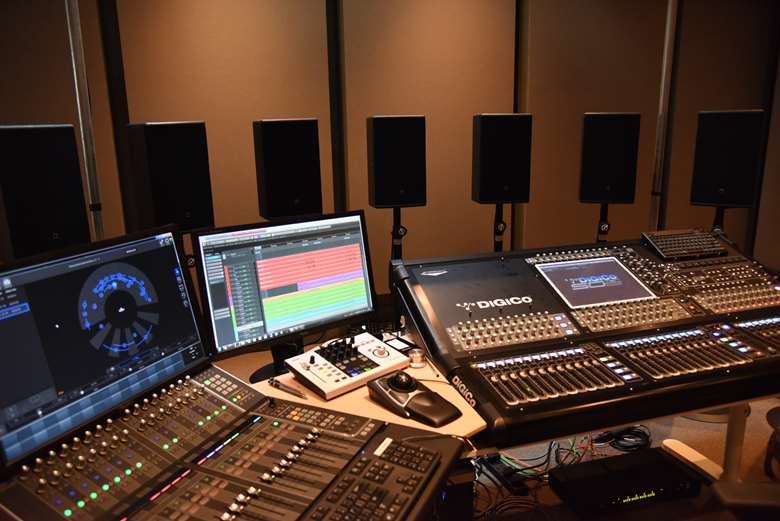Immersive recording technology that makes music sound ‘live’
Rafael Todes
Thursday, November 5, 2020
An innovative audio platform brings the multi-dimensional experience of a live performance into the realm of the recording studio

I recently spent an illuminating morning listening to the wonderful Latvian soprano Marina Rebeka singing bel canto arias on Spirito, a new album released on the Prima Classic label in March 2020. It’s available as a traditional two-channel CD. But more significantly, you can also listen on a brand new ‘immersive technology’ audio platform called The Bubble, where the performance comes from 23 speakers, located in the walls of a large room. Each channel contains different information, and gives the effect of great nuance and detail which is far beyond the scope of traditional stereo.
The company behind this new technology is a French company, L-Acoustics. Founded in 1984, by Dr Christain Heil, a PhD in Particle Physics, L-Acoustics has its roots as a Pro-Audio company, which built complex and sophisticated sound systems for live events. Then Dr Heil had an idea: why couldn’t such a pro-audio system be made available to a domestic user, to create a greater connection to the listener, closer to the experience of being on stage or among a live audience?
I caught up with Marina Rebeka and her sound engineer husband Edgardo Vertanessian, CEO of the Prima Classic label, who lovingly recorded the event and mastered it for the Bubble mix, realeased under the title Spirito. I asked Edgardo how recording with, in this case, 18 different tracks was different from the usual studio experience: ‘We recorded Spirito using some 64 audio channels [microphones] placed in many different specific positions in the Teatro Massimo [in Palermo, Sicily], because we knew we were going to make an immersive mix afterwards. All this has to be planned and decided in advance. After the recording in the theatre, which has wonderful acoustics, we went to our studio in Latvia and we mixed the 64 channels to make the stereo mix that you can hear on the CD. Then we did a completely different mix for Bubble, at the L-Acoustics Studio in Highgate, London. Basically, the difference is that to mix for an “immersive format”, you need to have more microphones and in different positions than in a standard stereo situation.’
I asked Marina how different the recording process felt from the point of view of the singer? ‘Actually, it felt exactly the same as any other recording, We just saw a few more microphones than usual! In this case, I was heavily involved in the editing process. From an artistic point of view, I had a clear idea of the musical result and sound I wanted and of course with so many microphones, I had so many different options. I left all the decisions about balance to Edgardo as he knows my voice very well.’
At present, The Bubble is intended as a high-end audio platform for the home – really the ultimate in multi-channel listening in a domestic environment. However, the wider applications in opera are obvious, especially when it comes to cinema relays and ‘arena experiences’ where L-Acoustics’ technology has far-reaching implications. ‘It’s the closest experience to the live performance,’ says Edgaro, ‘as you can clearly “feel” the position of each instrument-section and each singer in this huge and wide sound canvas in front of you, enveloping you as if you are standing in front of the orchestra. There is more separation and clarity between the sections and you can hear everything that everyone in the orchestra is doing.’
It’s the closest experience to the live performance, as you can clearly “feel” the position of each instrument-section and each singer in this huge and wide sound canvas in front of you
Do opera singers need a particular sort of microphone to capture the individual nature of the human voice? Edgaro explains: ‘A number of really good microphones are widely used for recording opera singers professionally, and there is a certain suitability between a particular microphone and a particular singer, based on the sound engineer’s preferences. My goal is always to make the voice sound as it does in real life, and as detailed as possible in the final mix. With a voice like Marina’s – capable of very delicate pianissimo and extremely strong fortissimo – this is done by a combination of mic placement during the recording, finding the correct balance and using the right tools during the mix. This takes a lot of time!’
Individual voices are one thing, but what about recording a whole opera, with all its myriad moving parts? ‘The singers don't need to actually move during an audio recording,’ says Edgardo, ‘as we can easily re-create their movements on the sonic landscape with a great deal of freedom during the mixing process. In the case of an audiovisual production being recorded, we could follow the singers’ movements in post-production. Conversely, if we were to use this technology to mix a live audio-visual stream for example, we could either manually follow the singers’ movements as they appear on the screen or we could programme the software to follow them automatically via the use of movement sensors.’

